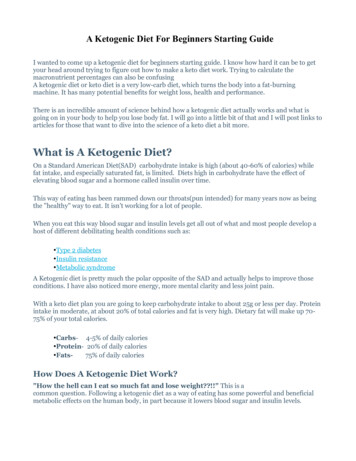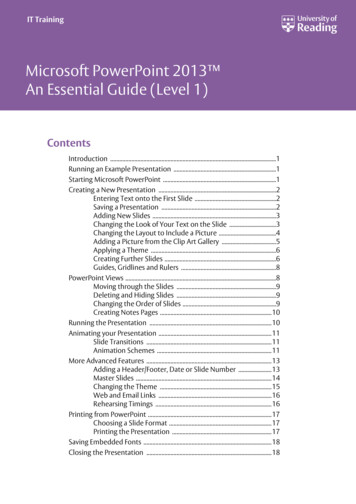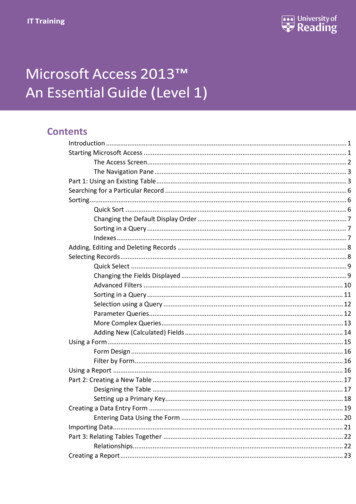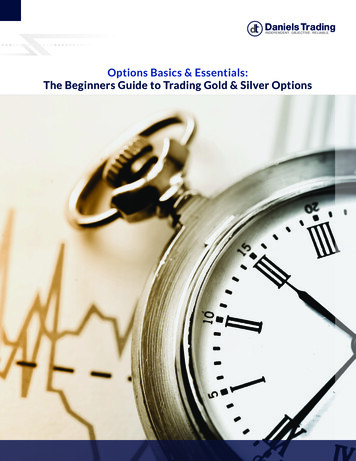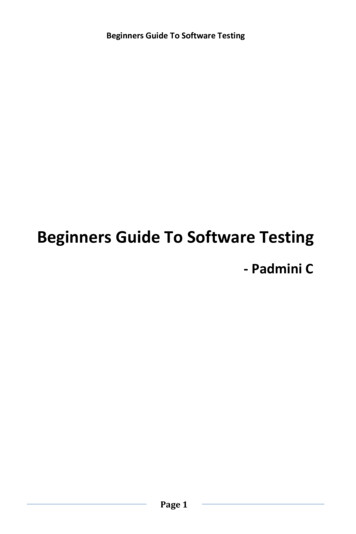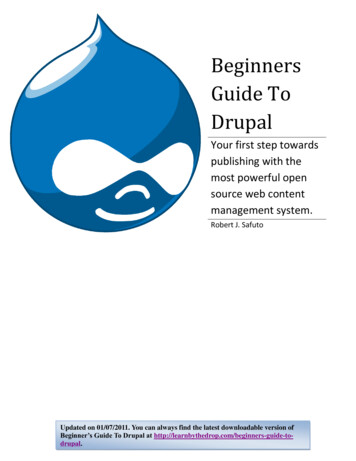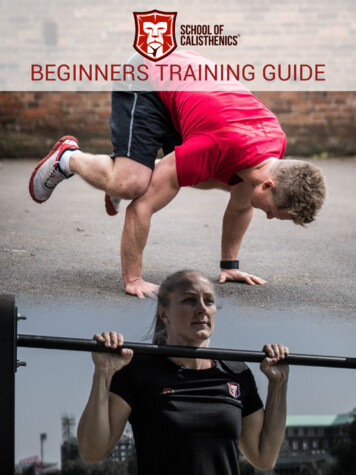
Transcription
www.schoolofcalisthenics.com A beginners guide to Calisthenics - 1
Welcome to the School of Calisthenics, we’re excited to have you on board.Calisthenics training is a journey packed with excitement, accomplishment and self-discovery.It’s more than just pounding away at the gym on the treadmill or on the bench press. It’s aboutexploring the physical movement potential we all have inside and mentally challenging ourselves toredefine our own impossible.If you apply what we are going to teach you, train hard with consistency and patience, as yourindividual journey progresses you are going to achieve some awesome feats of strength andcontrol. Movements like the human flags, handstands, muscle ups and levers might seem a millionmiles away but that is what the School of Calisthenics was established to teach.We are confident that we can support anyone to do things they currently believe to be impossible.But getting started is the hardest bit. Rather than watching videos of people doing amazing things,this beginners guide is going to give you the knowledge and tools to build the basic movementpatterns and strength, setting the foundations required to redefine your impossible!2 - A beginners guide to Calisthenics. www.schoolofcalisthenics.com
WHAT IS CALISTHENICS?www.schoolofcalisthenics.com A beginners guide to Calisthenics - 3
What is Calisthenics?Calisthenics is a form of physical training based primarily around mastering your own bodyweight,using minimal equipment. Calisthenics comes from the Greek words ‘kallos’ and ‘sthenos’, whichmean beauty and strength. When the Greeks saw bodyweight training all those years ago, theynamed it ‘beautiful strength’!Calisthenics combines strength training and basic gymnastic movements that can be doneanywhere; at home, in the park, at the gym or even in the office. It’s the most basic form of physicaltraining. The human body is designed to move and that very fact has enabled the human race tosuccessfully survive a multitude of extreme events and challenges throughout our history. Butmodern society and lifestyles are threatening the very thing that is at the core of our existence.Calisthenics represents a de-volution of training, going back to basics and exploring what amazingthings the body is capable of and in the process developing strength we can use in the world, notjust within the confines of a gym.Getting started in Calisthenics however is not easy. Not because it is complicated but simplybecause most people just don’t know how to begin. It looks difficult and might even feel physicallyimpossible. You are going to ask your body to move in ways it may never have done before or atleast not for a long time. With something so new and challenging you are going to need some helpand guidance to navigate the physical complexity. But now you’re part of the School of Calisthenicswe are going to help you learn new, seemingly impossible things. However it doesn’t end there, we’llalso help you to improve your physical fitness, conditioning, wellbeing, nutrition and maybe evenchange the way you approach the wider challenges you face in life! Calisthenics is not just good forour body it develops mental strength and fortitude as well.4 - A beginners guide to Calisthenics. www.schoolofcalisthenics.com
THE SCHOOL OF CALISTHENICS
The School of CalisthenicsThe School of Calisthenics was founded in 2016 but our roots go back much farther than that. Ourtutors have been working in the field of elite sport and athlete training for many years. They havetrained athletes who have won medals at European, Commonwealth, World and Paralympic level.This experience of coaching combined with relevant academic qualifications is what our school isbased on and we now want to share all that with you.Teaching students to achieve new, awesome and often seemingly impossible things throughcalisthenics is what all our tutors are passionate about. The School of Calisthenics foundations arebuilt upon the principle that when given the right education, coaching and guidance you can achieveawesome things. Things that you might previously have assigned to the ‘impossible’ box in yourbrain!Calisthenics is not impossible; even if it feels like that at the start, don’t worry. Our extensiveexperience in professional sport and elite performance strength and conditioning has enabled us todevelop an approach to teaching, which is progressive and systematic. We understand movement,physical adaptation and exercise physiology and the school exists to apply that within the realmof calisthenics. To do that we have created a unique framework which will take you from thisbeginners guide all the way to human flags, levers, muscle ups, handstands and beyond. We havedeveloped specific frameworks and exercises for each of these movements which can be found onour website schoolofcalisthenics.comWe are passionate about calisthenics and even more so about helping anyone begin their journeyby removing the barriers which often prevent them from even getting started, let alone becomingawesome.6 - A beginners guide to Calisthenics. www.schoolofcalisthenics.com
USING THE BEGINNERS GUIDETO CALISTHENICSwww.schoolofcalisthenics.com A beginners guide to Calisthenics - 7
Using the Beginners Guide to CalisthenicsThis guide is designed to give you an insight into the phases of the School of CalisthenicsFramework that will help you to build the foundation movements and basic strength needed tostart your Calisthenics journey. Once you’re ready you can either sign up to one of the Schoolof Calisthenics face to face workshops or set yourself a goal of training towards and achievingawesome things like; human flags, levers, muscle ups and handstand push-ups, with the use of ourdownloadable Training Programs.The School of Calisthenics framework is explained briefly in the following pages but for this guidewe are going to focus on two of the phases; Movement Preparation and Capacity Strength. Theother two components, Movement Patterning and Applied Strength relate to specific Calisthenicsmovements and the exercises and progressions necessary to achieve them.In the Training Programme section of this guide you’ll find links to exercise videos on our websiteshowing demonstrations and full coaching instruction from our School of Calisthenics tutors.The School of Calisthenics FrameworkThe framework is based on two key physical components: Movement and Strength. We’ve includedan overview below to give a brief explanation of how it works and how to use it, however moredetails can be found at MENTSTRENGTHPATTERNINGCAPACITYFigure one: The School of Calisthenics Framework8 - A beginners guide to Calisthenics. www.schoolofcalisthenics.com
STAGE ONE: MOVEMENTwww.schoolofcalisthenics.com A beginners guide to Calisthenics - 9
STAGE ONEMovementMovement is broken down into two sub-categories; Movement Preparation and MovementPatterning. This is such an important part for all Calisthenics movements as they demand highlevels of joint mobility and co-ordinated muscle activation.Movement PreparationMany of the calisthenics movements place a large emphasis on the shoulders. Our modernday lifestyles involve extended periods of sitting that often results in less than optimal posturalalignment. Shoulders become tight, rounded forwards, the head protrudes and we lose thoracicspine mobility. This is a long way from what position the body should be in and where it needs tobe for optimal force production needed in Calisthenics. If we ignore postural dysfunctions, we facean increased injury risk and can expect a limitation on our ability to progress. We must thereforeprepare the body for movement. It’s an ongoing process but real changes can be achieved inminutes within a session. Our aim is simply to remove muscular tension, improve muscle length,enhance mobility and activate the muscles we intend to use thus preparing us to move. Theultimate aim is to get back to as close to optimum posture as possible.Movement Preparation is a key element of this beginners guide as poor postural patterns are anepidemic and getting this sorted is the first step on everybody’s journey.Movement PatterningMovement Patterning is about teaching the brain and body new movements patterns. This isparticularly important when working towards a new Calisthenics movement (like a Human Flagor Reverse Lever for example) as your brain and body have never linked the muscles before intothe correct movement pattern. However this beginner’s guide focuses on building the foundationstrength to start your Calisthenics journey, rather than developing specific movement patterns,which will be covered in full detail in each of the specific training programs for the differentCalisthenics movements will be available at www.schoolofcalisthenics.com10 - A beginners guide to Calisthenics. www.schoolofcalisthenics.com
STAGE TWO: STRENGTH
STAGE TWOStrengthAs with Movement, the Strength component of the School of Calisthenics Framework also has twoelements; Applied Strength and Capacity Strength.Applied StrengthApplied strength is specific to a chosen calisthenics movement. For example, to do a reverse leveror a human flag for the first time means putting your body in a position it has never been beforeand applying high levels of muscle force in that shape. That takes some programming throughthe movement patterning but also by using progressive exercises that allow the body to build thestrength required. These exercises are specific to the goal or calisthenics movement and thereforethis phase of the framework will be covered in more detail in future training programs designed foreach specific calisthenics movements published on our website www.schoolofcalisthenics.comCapacity StrengthFor beginners this phase of the School of Calisthenics Framework is where the bulk of your trainingwill be done. Building a basic level of strength in a number of key areas will set you up perfectlyto chose your first calisthenics movement goal and begin your journey. It’s really important thatyou remember this key phrase; ‘earn the right to progress’. Often we see people jumping to moreadvanced movements without mastering the basics or relevant progressions. They want to gostraight to level 5 without really completing levels 2 to 4. Inevitably in all cases the athlete has tocome back to go through the stages properly if they are to achieve longer term success.The exercises in this phase are less specific, global strength exercises that will help build strength,however we can also develop neuromuscular control, postural stability, robustness and muscularco-ordination which are all essential in calisthenics movements. For example you can do push-upswithout thinking about it, or you can do push-ups with some coaching points from our tutors andget loads more physical adaptation which will transfer into your future training.12 - A beginners guide to Calisthenics. www.schoolofcalisthenics.com
THE TRAINING PROGRAMMEwww.schoolofcalisthenics.com A beginners guide to Calisthenics - 13
The Training ProgrammeBy now we hope that you are itching to get started so let’s introduce the exercises. Following thenext section there is some information about reps, sets, tempo, rest and how to structure sessionsso make sure you read that too as it’s really important in ensuring you get the physical adaptationyou’re after.The exercises we have included for you as part of this beginners guide are not just for peoplegetting started, we still do these exercises ourselves. The development and progression of basicstrength is essential and something that always needs developing.Movement Preparation Exercises:These selected exercises introduce some simple methods you can use to improve the range ofmovement around the shoulder and restore more optimal activation patterns. The shoulder is ajoint on which we inflict a lot of stress in day to day life due to poor postural control and modernlifestyles. It has a great capacity for movement but at the expense of stability so you need to lookafter it.Self Massage: Lats and posterior shoulder (Watch the video)A lot of muscular tension accumulates around the muscles acting on the shoulders and to restorerange of motion and movement quality we need to release it. Try this for 1 – 2 minutes on each armat the start of your session.Mobilisation: Hanging Lat Stretch (Watch the video)Once some tension has been released you can further enhance the mobility of the shoulder jointusing this simple exercise. Hang out in this position adjusting the shape gently to find the tightareas for around 1 minute on each arm .Activation: Floor Y T W (Watch the video)To get ready for training, muscles need switching on and waking up. Following the self-massageand mobilization exercises we complete movement preparation by telling the brain to activatecertain muscles, which improves postural control and movement quality. Developing strength andactivation in the mid and lower trapesius is something you will always need to do.Reps:Sets:Tempo:10 (a complete sequence of 1 x Y T W equals 1 rep)2Pause for 2 seconds in each position14 - A beginners guide to Calisthenics. www.schoolofcalisthenics.com
CAPACITY STRENGTH EXERCISESwww.schoolofcalisthenics.com A beginners guide to Calisthenics - 15
SECTION ONE: PUSH EXERCISES16 - A beginners guide to Calisthenics. www.schoolofcalisthenics.com
SECTION ONEPush ExercisesPush-up variationsThere is so much more to push ups than the standard variation most people know. Firstly a lotof people don’t do them with correct technique and that is always the priority. Secondly there areloads of progressions that make this a really challenging movement. We have included a few to getyou started.Standard Push Up (Watch the video)Everyone knows how to do a push up right? Wrong. Correct arm positioning and postural control isessential in maximizin
4 - A beginners guide to Calisthenics. www.schoolofcalisthenics.com What is Calisthenics? Calisthenics is a form of physical training based primarily around mastering your own bodyweight, using minimal equipment. Calisthenics comes from the Greek words ‘kallos’ and ‘sthenos’, which mean beauty and strength. When the Greeks saw bodyweight training all those years ago, they



